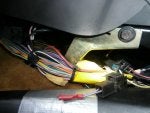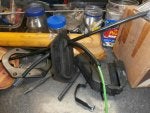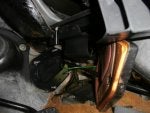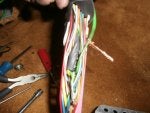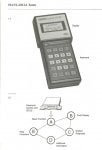Yes, this is not a typo, we are indeed talking Motronic ML4.1 and the Fiat-Lancia Tester (FLT).
Thanks to the generosity of Allan our Swedish BBer I have been able to try out a rare Marelli MA1B/GB module with the FLT which is specifically designed for the Bosch Motronic ML4.1 system used on series 1 164s (2.0 TS, 3.0 12v V6, Base, QV & S).
This module is also appropriate for the Spider 2.0 SZ, the 75 1.8—1.8E—2.0 TS— 3.0 V6, and the 33 IE Jetronic LE3.1/2 Motronic ML4.1 8V—16V. Don’t confuse this with Marelli MA4A which is the test module for 24v 164s with Bosch 1.7 Motronic systems, or Marelli MA10A for the 164 Q4 with Motronic 3.7 (By the way I can provide the eprom chips for any of the above)
Albeit that venerable BBer Goats has mentioned that he has found the FLT plus suite of 5 modules that Alfa North American offered of little use for 24v cars, the suspension module (M4B) is a notable exception, indispensable for diagnosing suspension faults on the Controlled Damping System (a.k.a electronic suspension) on both 12v and 24v cars (QV, S, Q & Q4). Since there doesn’t seem to be any documentation on the web for using the FLT + motronic ML4.1 on series 1 164s this post will attempt to rectify that. So what does the MA1B do, you may ask?
First of all (thank you Steve Alfisto), you need to literally dig out the T1 connector in front of the left foot of the passenger, under the carpet just forward the light under the glove box. Although you might be able to get your hand in there, in all likelihood you will need to remove first the passenger tunnel carpet (first slide back center console, remove two carpet screws + loosen left front seat rail); you see immediately the stack of ECUs behind the radio, just follow the motronic cable to the right, after about 12” from the ECU you’ll see T1. You can reroute it over the floor carpet and put everything back again. T1 has a nice little protective cap to keep dust out.
Once the FLT + module MA1B handshake you’ll be prompted to select “motronic” or “jetronic” and then answer the question “engine with lamda probe <OK>”; then it prompts you to turn the key to ”MAR” (not start), and the first series of tests will be available for the stationary car.
You will have two options, one, to manually check individual values or two, to see any stored errors.
the individual tests tell you (on my cold car) ...
At this point the FLT displays “The data which follow are valid only with ENGINE RUNNING”
A lot of this could be very valuable for troubleshooting (realtime engine temperature, fuel injection values, compressor operation, etc.)
I cannot comment at this time on the FLT’s “memorization of errors” as my car returned the message “no errors stored”. The depth of analysis might be very interesting.
Four additional tests: idle speed actuator, injectors, timing variator (T-spark only) and evaporation solenoid valve can be executed by entering the FLT's Function E (by pressing M).
Fiat-Lancia Tester for Motronic ML4.1
Thanks to the generosity of Allan our Swedish BBer I have been able to try out a rare Marelli MA1B/GB module with the FLT which is specifically designed for the Bosch Motronic ML4.1 system used on series 1 164s (2.0 TS, 3.0 12v V6, Base, QV & S).
This module is also appropriate for the Spider 2.0 SZ, the 75 1.8—1.8E—2.0 TS— 3.0 V6, and the 33 IE Jetronic LE3.1/2 Motronic ML4.1 8V—16V. Don’t confuse this with Marelli MA4A which is the test module for 24v 164s with Bosch 1.7 Motronic systems, or Marelli MA10A for the 164 Q4 with Motronic 3.7 (By the way I can provide the eprom chips for any of the above)
Albeit that venerable BBer Goats has mentioned that he has found the FLT plus suite of 5 modules that Alfa North American offered of little use for 24v cars, the suspension module (M4B) is a notable exception, indispensable for diagnosing suspension faults on the Controlled Damping System (a.k.a electronic suspension) on both 12v and 24v cars (QV, S, Q & Q4). Since there doesn’t seem to be any documentation on the web for using the FLT + motronic ML4.1 on series 1 164s this post will attempt to rectify that. So what does the MA1B do, you may ask?
First of all (thank you Steve Alfisto), you need to literally dig out the T1 connector in front of the left foot of the passenger, under the carpet just forward the light under the glove box. Although you might be able to get your hand in there, in all likelihood you will need to remove first the passenger tunnel carpet (first slide back center console, remove two carpet screws + loosen left front seat rail); you see immediately the stack of ECUs behind the radio, just follow the motronic cable to the right, after about 12” from the ECU you’ll see T1. You can reroute it over the floor carpet and put everything back again. T1 has a nice little protective cap to keep dust out.
Once the FLT + module MA1B handshake you’ll be prompted to select “motronic” or “jetronic” and then answer the question “engine with lamda probe <OK>”; then it prompts you to turn the key to ”MAR” (not start), and the first series of tests will be available for the stationary car.
You will have two options, one, to manually check individual values or two, to see any stored errors.
the individual tests tell you (on my cold car) ...
1) current static voltage at the ecu : BATTERY V. 12,1 V
(because the battery is located in the trunk there will always be a voltage drop at the ECU; the ECU needs a minimum of 10 volts to properly adjust engine speed when various electrical loads are applied)
2) current intake temperature in C°: INTAKE AIR TEMP + 9° C
(on a cold engine air and coolant temperature will be almost the same, air temperature possibly a degree or two higher)
3) current engine coolant temperature in C°: ENGINE WATER TEMP +8° C
(on a cold engine coolant temperate will be very close to ambient if not the same; this check helps to verify the ECU is getting correct information in order to adjust mixture for cold start; tip: a reading of -30°C automatically indicates an open circuit in the CTS wiring, >+99.9°C indicates a short circuit; as the engine is warming you will be able to observe the tipping point of the thermostat, the relationship of ECU-inferred coolant temperature and gauge reading, and the exact switching point of the low-speed fan. Be mindful that fan switch, located at top of radiator, is far removed from thermostat body on head and has a life of its own)
4) state of minimum throttle aperture switch: ON [pressing the accel pedal: OFF]
(a very easy way to be sure TPS throttle position sensor is adjusted properly; improper adjustment or a failed TPS can result in slightly delayed acceleration, random stalling, increases speed on its own & CEL)
5) state of maximum throttle aperture switch: OFF
(also known as WOT or wide open throttle; at WOT the O2 sensor which tell the ECU what the air/fuel should be is no longer in the loop, instead a predetermined fuel map is used)
6) status (on or off) of the anti-theft system: OFF
At this point the FLT displays “The data which follow are valid only with ENGINE RUNNING”
7) BATTERY V. 13,9 V [changes as car idles or if you press the accel]
(these readings show if the charging system is working within specs)
8) INTAKE AIR TEMP +9° C [it's still cold outside!]
9) ENGINE WATER TEMP +28° C [engine is warming up!]]
(reading will gradually rise as engine comes to full operating temperature ≈99°C, this is also useful to verify that the temperature gauge is accurate)
10) MINIMUM THROTTLE SWITCH OFF
11) MAXIMUM THROTTLE SWITCH OFF
12) ANTI-THEFT DEVICE OFF
13) COMPRESSOR SWITCH DISENGAGED [ENGAGED when button pressed]
14) CONDITIONER SWITCH DISENGAGED [ENGAGED when “auto” pressed]
(this is useful for verifying if the compressor is being powered on or not)
15) ENGINE RPM 760 [in realtime]
(essential for idle management; verifies correct idle rpm and ECU-adjusted idle when various external loads are activated; the signal originates from the crank position sensor, specifically the lack of 2 teeth on the phonic wheel is the reference signal for the ECU to determine parameters such as ignition advance, ignition timing, richness)
16) INJECTION TIME 3.32 sec [constantly changing value]
(injector duration is nominally ≈3ms (as low as 1.5ms), in the event of the loss of an injector the ECU will increase the injection duration of the others from ≈3ms to as much as ≈11ms; injectors are controlled in parallel, where finely atomized fuel will briefly rest upon the back of a valve before being drawn into a cylinder.)
17) LAMBDA PROBE - REACHES CONDITIONS OF OPERATION
(Lambda voltage typically ranges from .8 volts (≈rich) to .2 volts (≈lean); readings outside of this range will throw a CEL; the cause of a CEL—imperfect combustion—could be many things, air leak, bad CTS, etc, etc)
18) LOAD [=AIR FLOW VALVE] 2.35 MSEC [at idle, changing constantly, and if revved]
A lot of this could be very valuable for troubleshooting (realtime engine temperature, fuel injection values, compressor operation, etc.)
I cannot comment at this time on the FLT’s “memorization of errors” as my car returned the message “no errors stored”. The depth of analysis might be very interesting.
Four additional tests: idle speed actuator, injectors, timing variator (T-spark only) and evaporation solenoid valve can be executed by entering the FLT's Function E (by pressing M).
Fiat-Lancia Tester for Motronic ML4.1


